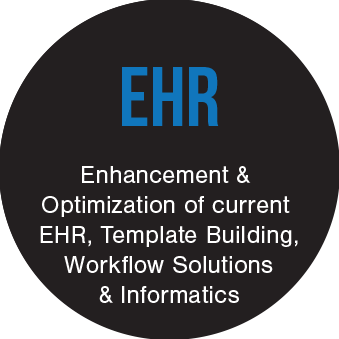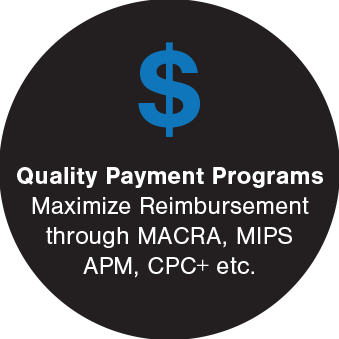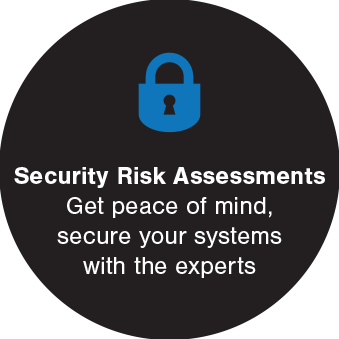Born out of the initial electronic push that payers began undertaking in 2000, Clinical Quality Initiatives designed to improve patient outcomes have evolved into the manner by which healthcare providers are being measured and compensated today. This is no longer the future of healthcare. It is today’s healthcare environment, which requires the integration of clinical quality in order to position an organization for success.



Elevation Healthcare has managed clinical quality initiatives and associated reporting for hundreds of physicians and their leadership for over 15 years. Our experience within multiple practices of all sizes and specialties, along with all of the various EHR systems, has enabled us to develop proven processes that will save you money, achieve regulatory compliance, and accomplish the results your business plan requires. We encourage you to look to us as the preeminent resource for enhancing workflow improvement, HIPAA and MACRA compliance, and the achievement of MIPS, APM, CPC+, MU, PQRS, VBM, PCMH & PCSP.
Medicare Access and CHIP Reauthorization Act of 2015 (MACRA) introduces the Quality Payment Program which streamlines current quality programs, such as MU, PQRS & VBM. Did you know physicians' reimbursement will now be tied to their value based composite score? The first performance youar for these programs begins in 2017. NOW is the time to begin building your composite score.
Merit-Based Incentive Payment System (MIPS) is a new program that combines parts of the Physician Quality Reporting System (PQRS), the Value Modifier (VM or Value-based Payment Modifier), the Medicare Electronic Health Record (EHR) incentive program and (PCMH) Practice Centered Medical Home into one single program.
Advanced Alternative Payment Models (Advanced AMPs) are new approaches to paying for medical care through Medicare that incentivize quality and value. Advanced APMs must meet certain criteria as defined by MACRA to qualify.
Two new reimbursement models aiming to stengthen primacry care through a regionally-based multi-payer payment reform and care delivery transformation. CPC+ is a five-year model that will begin in January 2017. Registration deadlines are fast approaching.
All stages for any 2014 Certified EHR
Significant challenges in successfully attesting to Stage 2 of MU: requires Patient Engagement, Care Coordination and a Health Information Exchange strategy
Focus on aligning quality initiatives to reduce the burden of reporting and streamline the quality improvement efforts. Ex; PQRS/MU/PCMH
MU audit defense preparedness and support: pre and post-payment audits are occurring annually on 5-10% of all healthcare providers who attest to MU
2015: Medicare Physician Fee Schedule payment adjustments begin for not demonstrating MU. Payment adjustments in future years can reach as high as 5%
CMS quality reporting program in which reporting methodology, requirements and specific measures change annually
Incentive payments ending in 2014 but penalties for not reporting continue:
not reporting in 2015=2% Medicare PFS reduction in CY 2017*In addition, Will be subject to the VBM payment adjustment for not reporting PQRS: Solo providers and groups with 2-9 providers=-4% total (2% value modifier penalty + 2% PQRS penalty), Provider groups with 10 or more providers this total non-reporting penalty will be 6% (4% VBM penalty + 2% PQRS penalty)
PQRS data reported in 2015 to be made publically available on all providers via the CMS Physician Compare website
Mandated under the ACA requiring CMS begin applying a value modifier under the Medicare Physician Fee Schedule. In 2015 this applies to all physicians and utilizes PQRS reported quality data and Medicare cost data to determine a provider’s overall value score, referred to as quality tiering. The VBM has the potential to reward high-performing providers with increased payments and reduce payments to low-performing providers, ultimately effecting approximately 900,000 physicians.
The Patient Centered Medical Home is a care delivery model whereby patient treatment is coordinated through their primary care physician to ensure they receive the necessary care when and where they need it, in a manner they can understand.
PCMH initiatives active in Ohio with potential for additional reimbursement for care coordination efforts: http://www.pcpcc.org/initiatives/ohio
Like PCMH, this delivery model now incorporates specialty practices committed to access, communication and care coordination to the “neighbors” that surround and inform the medical home and colleagues in primary care.
Practices that become recognized will demonstrate patient-centered care and clinical quality through: streamlined referral processes and care coordination with referring clinicians, timely patient and caregiver-focused care management and continuous clinical quality improvement.
The Office of Inspector General (OIG) released an amended policy to "protect the integrity of the Department of Health and Human Services (HHS) programs". The result of this amended policy, is that OIG audits are taking a much deeper dive into security. As many practices did in the past, a simple excel spreadsheet that lists your security risks is no longer acceptable. The OIG will now send an e-mail to the practice and request information to be returned within 10 days. If the practice does NOT satisfactorily comply with the request, the OIG will conduct a 2-3 week on-site audit with the practice and their Business Associates whom access PHI. The key is to be prepared before the practice receives an e-mail.
The OIG audits will focus on the following points of interest:
Elevation Healthcare has developed a comprehensive solution that assists practices with compliance issues, identifies high risk items, and includes a HIPAA Policy and Procedures manual. These are best practices that industry experts have formulated to comply with the technical requirements of the HIPAA Security Rule.
(ONC Guide to Privacy & Security of Health Information)
Elevation Healthcare partners directly with physician groups. We hold steadfast to operate agnostically as the advocate for the provider and practice, and therefore are able to partner with many other entities whom also share in the overall well-being and betterment of the physicians they serve. Partner entities which EH currently provides value-add services to are as follows: